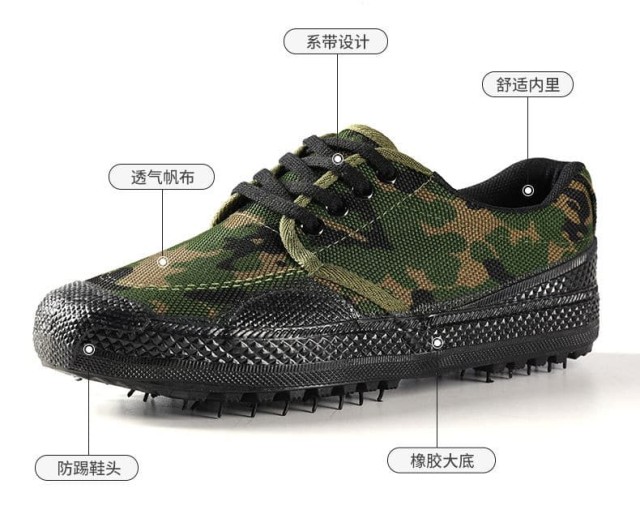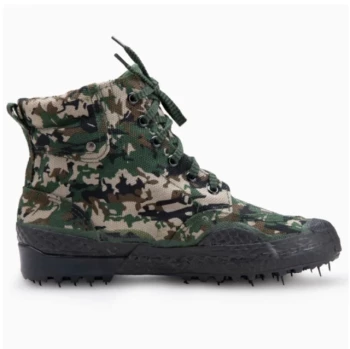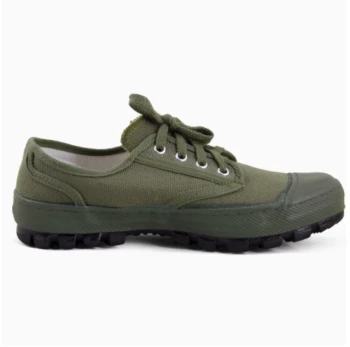Vulcanized shoes have long been favored for their flexibility, lightweight feel, and long-lasting wear. But what truly sets them apart is the meticulous finishing process—each step carefully engineered to enhance structural integrity, arch support, and overall comfort. Whether you're a distributor, brand owner, or bulk buyer, understanding these finishing techniques ensures you select footwear that meets the highest durability standards.
This article breaks down the science behind vulcanized shoe construction, the critical role of heat activation in bonding materials, and the strict quality control measures that guarantee long-term performance.
The Science Behind Vulcanized Shoe Construction
Vulcanization isn’t just about sticking rubber to fabric—it’s a carefully calibrated process that transforms raw materials into resilient footwear. Two key stages define this transformation: toe lasting and shank lasting.
Toe Lasting: The Foundation of Toe Box Structural Integrity
The toe box is one of the most stress-prone areas in any shoe. Poorly constructed toe caps lead to premature wear, discomfort, and even foot injuries. In vulcanized footwear, toe lasting involves:
- Precision Stretching: The upper material is pulled taut over the last (the foot-shaped mold) to eliminate wrinkles that could weaken the structure.
- Adhesive Application: A specialized rubber-based adhesive ensures the upper bonds seamlessly with the foxing (the strip that wraps around the shoe).
- Heat Compression: Controlled heat activates the adhesive, creating a permanent bond that resists peeling even under repeated flexing.
This process ensures the toe box maintains its shape, preventing collapse while allowing natural foot movement.
Shank Lasting and Arch Support Engineering
Unlike casual vulcanized shoes, performance-oriented designs require reinforced arch support. The shank—a rigid or semi-rigid insert—is placed between the insole and outsole to:
- Distribute Weight Evenly: Reduces strain on the plantar fascia, minimizing fatigue during prolonged wear.
- Enhance Stability: Prevents excessive foot rolling, which can lead to ankle injuries.
- Optimize Flexibility: A well-designed shank allows controlled bending at the metatarsal joint, improving natural gait.
For bulk buyers, this means fewer returns due to comfort complaints—a critical factor in maintaining customer satisfaction.
Heat Activation in Foxing Pressing
The vulcanization process hinges on heat’s ability to fuse materials at a molecular level. Two factors determine success: material bonding dynamics and outsole-vamp integration.
Material Bonding Dynamics in Vulcanization
Not all adhesives respond the same way to heat. Industry-leading manufacturers use sulfur-based compounds because:
- Cross-Linking Formation: Sulfur creates strong molecular bridges between rubber polymers, enhancing elasticity and tear resistance.
- Temperature Precision: Too little heat results in weak bonds; too much degrades the material. Optimal vulcanization occurs between approximately 280°F to 320°F (138°C to 160°C).
- Time-Dependent Curing: Bonds strengthen over 24–48 hours post-production, reaching maximum durability.
Outsole-Vamp Integration for Flexural Resistance
The vamp (front upper) and outsole must move as one unit. Poor bonding leads to:
- Delamination: Separation between layers, causing discomfort and shortening shoe lifespan.
- Cracking: Repeated stress on weak bonds fractures the rubber.
High-pressure foxing presses ensure:
- Uniform Adhesive Spread: Eliminates air pockets that weaken bonds.
- Contoured Compression: Matches the foot’s natural curvature for consistent flexibility.
For distributors, this translates to products that withstand rigorous use—whether for sports, work, or daily wear.
Quality Control Protocols in Finishing
Even minor deviations in pressing tension or curing times can compromise durability. Reputable manufacturers enforce strict checks at multiple stages.
Tension Calibration in Pressing Machines
- Force Measurement: Pressing machines apply roughly 15–20 psi to ensure adhesion without distorting the shoe’s shape.
- Real-Time Adjustments: Sensors detect uneven pressure, automatically correcting it to prevent weak spots.
Industry Standards for Adhesive Curing Times
- Post-Press Resting: Shoes remain in climate-controlled storage for at least 24 hours to allow full curing.
- Peel Testing: Random samples undergo stress tests to verify bond strength meets ASTM D413 standards.
For brand owners, these protocols mean reliable products that uphold their reputation for quality.
Final Thoughts: Why Finishing Details Matter
Vulcanized shoes aren’t just glued together—they’re engineered. Every step, from toe lasting to final curing, directly impacts how long they last and how comfortable they feel. For bulk buyers and distributors, partnering with a manufacturer like 3515 ensures access to footwear built with:
- Architectural Precision: Each component is placed for maximum support and flexibility.
- Material Science Expertise: Advanced adhesives and curing techniques prevent premature wear.
- Rigorous Testing: Every batch meets international durability benchmarks.
Ready to stock high-performance vulcanized footwear? 3515 combines large-scale production with meticulous finishing—delivering shoes that keep end-users comfortable and coming back for more.
By understanding these processes, you’re better equipped to evaluate suppliers and select footwear that balances durability, comfort, and cost-efficiency. After all, the best shoes aren’t just made—they’re perfected.
Related Products
- Durable Spiked Camouflage Boots Wholesale & Factory Production
- Durable Rubber Sole Outdoor Shoes Wholesale & Custom Manufacturing
- Wholesale High-Traction Camo Boots - Custom Manufacturer for Brands
- Durable Rubber-Soled Utility Shoes for Wholesale & Custom Brand Manufacturing
- Wholesale Durable Camo Canvas Shoes with High-Traction Rubber Soles
Related Articles
- Vulcanized vs. Cupsole Skate Shoes: How to Choose Based on Your Skating Style
- Cupsole vs. Vulcanized Shoes: How Construction Impacts Performance
- How Vulcanized Skate Shoes Elevate Technical Performance: A Skater’s Guide
- Optimizing Vamp Production for Vulcanized Shoes: Materials, Techniques, and Quality Assurance
- How to Choose Between Vulcanized and Cupsole Skate Shoes for Optimal Performance



















